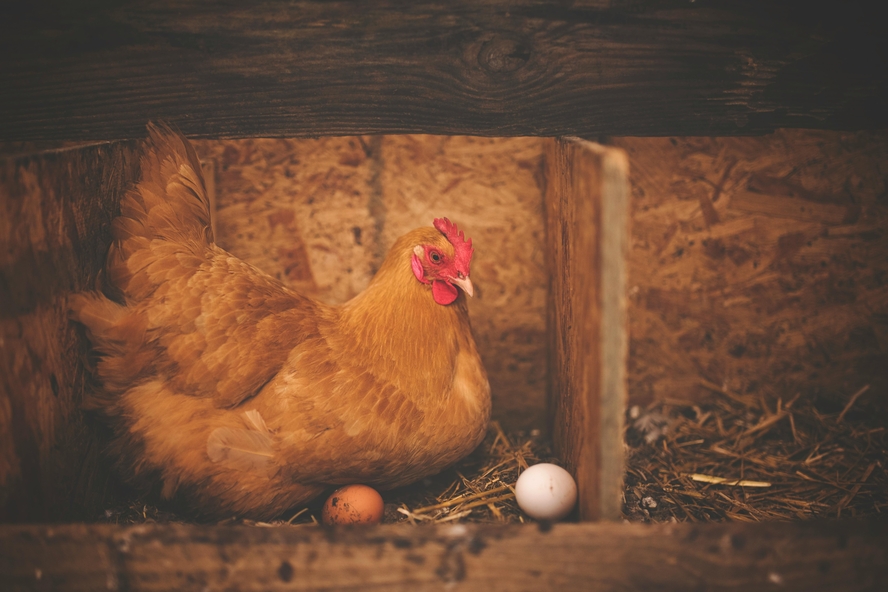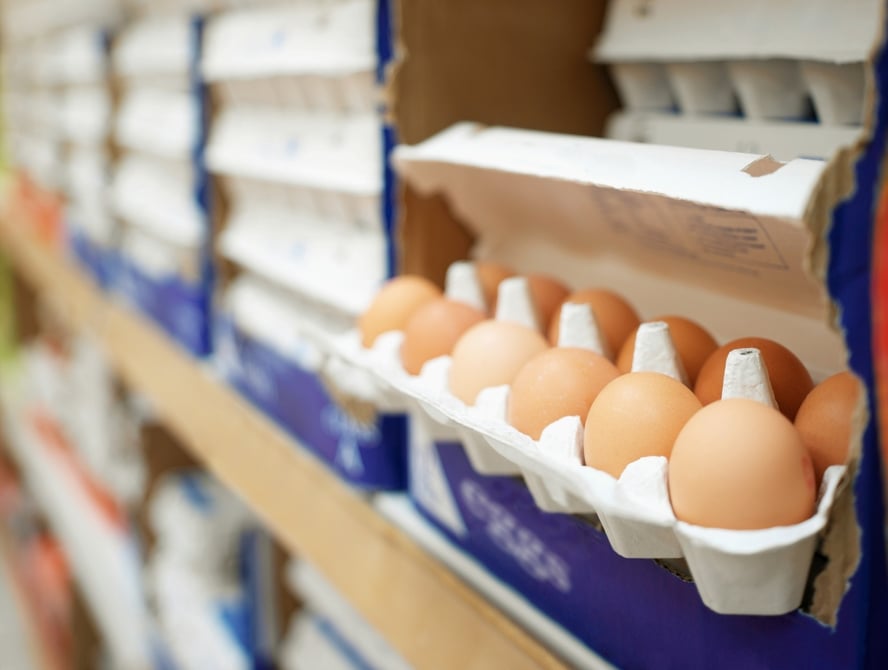What Are Cage-Free Eggs? New Organic Regulations Help Define Things, But Consumers Still Need to Do Their Homework
On the first day of 2025, the new Organic Livestock and Poultry Standards will go into effect, changing the definition of what constitutes a cage-free, organic egg. Here’s what that means for us as consumers.

Breaking news: You may soon be seeing bare shelves where the cage-free organic eggs once sat in the grocery store. You might assume this is linked to the recent outbreak of avian flu, but the shortage isn’t what it seems.
While bird flu is still a persistent problem impacting the availability and price of eggs across the United States1, this new dearth is actually linked to a change in the regulations on what constitutes a cage-free organic egg. No surprise, many producers who once met the guidelines now no longer do.
“The many industrial-scale cage-free facilities that wish to maintain organic status will need to make enormous adjustments to their animal agriculture models,” explains Cameron Whitehead, COO of Pete & Gerry’s Organic Eggs. “The new standards will force cage-free farms to enhance their hens’ outdoor living space in a way they haven’t yet explored, largely due to cost implications.”
What Are Cage-Free Eggs?

Before we dive into the new regulations, what does a “cage-free” claim on your carton of eggs currently mean? Well, unfortunately, part of the need for new regulations stems from a lack of consistency in the definition. In theory, cage-free eggs are hatched from hens that do not live in cages and have the freedom to roam during the laying cycle. In practice, the rules are so ambiguous that the outcome is far from humane.
For example, it’s not uncommon for large cage-free egg facilities to essentially operate as warehouse factories. Although there may not be any cages in sight, the overcrowded conditions are almost as bad. And without clearer regulations around both cage-free claims and organic status, it will remain difficult to separate the humane eggs from the inhumane ones.
The New Regulations
The new Organic Livestock and Poultry Standards were announced by the USDA last October and go into effect on January 1, 2025, with plans to roll out more regulations through 20292. These regulations represent “significantly improved humane conditions for cage-free hens that are being raised organically,” says Whitehead.
The many industrial-scale cage-free facilities that wish to maintain organic status will need to make enormous adjustments to their animal agriculture models.
Cameron Whitehead, COO of Pete & Gerry’s Organic Eggs
With the rollout of the new standards, cage-free organic egg-laying hens will enjoy increased perch and feed space. Perhaps most importantly, the screened-in, enclosed porches attached to the buildings that house these birds will no longer qualify as sufficient outdoor space.
The Loophole in the Existing Regulations
The existence of these porches is linked to a loophole in what qualifies as access to the outdoors, explains Mark Kastel, one of the founders of organic industry watchdog OrganicEye. Many large factory farms in the U.S. — even USDA Certified Organic ones — confine thousands of birds to just one building “with a concrete floor, screened walls, and metal ceiling,” says Kastel.
The “outdoor” porches attached to these buildings only have the capacity to hold a mere fraction of the birds. Kastel explains that the floors of the buildings are so packed that it makes it incredibly difficult for birds to squeeze their way past each other to go outdoors. “The only birds that get out would be right next to the door,” he says.

To make matters worse, these farms typically use giant fans to whisk away the ammonia created by the tons of manure in these spaces. This creates “a hurricane wind” outside the building, says Kastel, which further dissuades birds from taking advantage of their “outdoor” space. “I would suggest that 97% of them are being illegally confined without access to the outdoors.”
That said, Kastel doesn’t see the new standards as a true step forward, either. “The existing rules were adequate,” he says, alleging that the USDA deemed them “too ambiguous” for enforcement. “But the organic standards as they existed weren’t being enforced.”
Nevertheless, the new benchmarks mean giant livestock factories can’t continue to operate as they once did. Kastel expects larger operations to meet the new regulations by contracting with mid-sized Amish and Mennonite farms, which keep their hens in buildings with a 20,000 to 40,000 bird capacity. Unfortunately, he still expects that “a very small percentage of those birds will actually be outside.”
The Benefits of Truly Humane Eggs
Aside from the obvious, there are also selfish reasons to push for more stringent regulations. Truly humane, organic, pastured eggs have proven to be more flavorful and more nutritious than conventional, with a 2010 study showing that eggs laid by pastured hens were richer in omega-3 fatty acids and vitamins A and E3. The researchers at Penn State’s College of Agricultural Sciences found that these additional nutrients stem in large part from the diet of natural insects and foraged grasses that pastured hens enjoy.

While the new regulations are a push in the right direction in terms of the humane treatment of egg-laying hens, there is no evidence that they will make a meaningful enough difference to contribute to improved flavor or nutrition. Luckily, there have long been small farming operations committed to producing humane eggs. For example, Pete & Gerry’s pasture-raised eggs come from hens that roam outdoors with at least 108 square feet of space per hen.
How to Identify Humane Eggs
Truly humane, organic, pastured eggs have proven to be more flavorful and more nutritious than conventional, with a 2010 study showing that eggs laid by pastured hens were richer in omega-3 fatty acids and vitamins A and E3.
To find more humane eggs, consumers need to look a bit closer at their egg cartons. And despite the crackdown on regulations, the USDA Certified Organic label still isn’t quite enough. Here’s what you should look out for.
Brands to Buy From
If you’re in a rush and just want some widely available brands you can trust, Kastel recommends Vital Farms and Handsome Brook. Both of these farms approach a pastured mindset that Kastel terms “enhanced outdoor access.” While their hens all live in fixed houses and should be distinguished from truly pasture-raised birds, the buildings have more doors than most, and the farmers make a genuine effort to encourage their birds to go out.

Seals and Labels to Look For
For truly humane eggs, Whitehead recommends looking for the Certified Humane seal, paired with labels like ‘pasture-raised’ or ‘free-range.’ Certified humane eggs mean that the egg producers have met rigorous standards set by the Humane Farm Animal Care organization. In other words, you can trust that the hens that laid the eggs had ample space to lay eggs with minimal distress.
Free-Range vs. Cage-Free
There’s a common debate about two labels you might see on your eggs: free-range vs. cage-free. When it comes to free-range eggs vs. cage-free, the terms shouldn’t be used interchangeably. Free-range eggs represent a step up. “These terms mean that the eggs have been produced by hens that live a natural lifestyle and have the freedom to roam outdoors on pastureland,” says Whitehead.
Pasture-Raised vs. Free-Range
Armed with your new knowledge about the loopholes in cage-free egg regulations, you can probably guess that both pasture-raised and free-range eggs are more humane than cage-free eggs. But what’s the difference between the two?
The main distinction between these two labels is the minimum amount of outdoor space provided to the hens. Free-range eggs require each hen to receive a minimum of two square feet of pasture. This already represents a huge improvement compared to cage-free eggs — but pasture-raised eggs take things even further. To qualify as a pasture-raised egg, the hens must each have a minimum of 108 square feet to roam.
How to Find the Very Best Eggs

If you’re really committed to animal welfare and want to do your own research, there are a few additional things you can look for beyond the typical labels. For the very best eggs, Kastel recommends looking for locally marketed, pastured eggs. “That’s where you’re gonna find truly organic eggs.”
For example, he mentions Joel Salatin, owner of the pioneering Polyface Farm in Swoope, Virginia. “He has what he calls an eggmobile, a big trailer that he moves every single day, out in a real pasture,” explains Kastel4. “The birds are never in their own excrement. And they’re always with fresh grass or weeds or bugs, or whatever they’re eating.”
As opposed to most organic farms he visits, where he sees about two to three percent of birds outdoors at any given time, Kastel was happy to see a marked difference at Polyface Farm. “At Joel’s farm in Virginia, there weren’t three percent of the birds out. There were two or three percent of the birds inside.”
“For the very best eggs, look for locally marketed, pastured eggs. That’s where you’re gonna find truly organic eggs.”
Mark Kastel, Co-Founder of OrganicEye
Salatin is only one of several small producers raising egg-laying hens in such a humane, eco-conscious way. To find a similarly humane source of eggs near you, Kastel recommends tracking down your local egg producers: at the farmer’s market, member-owned food co-op, or independently-owned natural food store. Resources like Eat Wild or The Real Organic Project make this a bit easier, allowing you to find the best retailers near you.
“If you want the best food, beyond the minimum in organic, it takes a little more effort to do your homework,” says Kastel. “But I say it’s worth it.”
Sources:
- https://www.msn.com/en-us/food-and-drink/recipes/bird-flu-impacting-local-egg-prices-stores-strive-to-keep-costs-low/ar-AA1vicBk
- https://ota.com/advocacy/critical-issues/organic-animal-welfare-standards
- https://www.psu.edu/news/agricultural-sciences/story/research-shows-eggs-pastured-chickens-may-be-more-nutritious
- https://www.youtube.com/watch?v=V_nZNGSZAII

